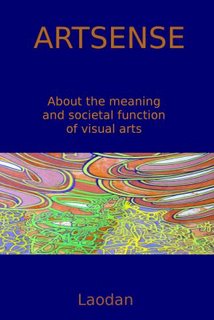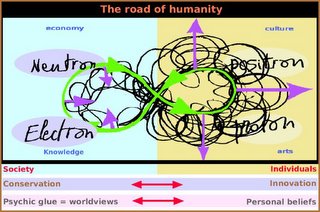Visualizing something that our eyes can't see....
With science the first action, in visualization, is no longer going from the eyes to the brain as earlier. Now the action comes first from an abstraction imagined by the mind, or by a piece of software. That abstraction first transits through a digital rendering and then it reaches the eyes. All this is done in order to make things better understandable... For sure visualization is always a question of service at the attention of the brain in the last instance.
I guess that in the long future our eyes will learn to see with the brain and automatically detect patterns and meaning where we saw none earlier. This new visualization trend could be a sign that we are on the verge of a human mutation without precedent... at least if the human genie has not succeeded to extinguish the human race before that.
But let's be clear this has already unlocked 2 sets of fundamental and, should I say, inescapable implications for the visual arts:
- in light of this dramatic revolution in the act of seeing there is just no way any longer that representations of what our eyes see directly could still be accepted as art. (portraits, landscapes, stills,...) Such representations are indeed based on a mode of perception that reigned in the past and as such they are no longer artistically significant. At best such representations are crafts for interior decoration.
- in light, on the one hand, of the inversion of the action of visualization from the brain to the eyes that has been unlocked by science recently which, on another hand, also happens in a globalizing environment where the philosophies and ways of understanding reality by the majority of the people on this earth will displace whitemen's dualism... well, in light of all that, visual arts are definitely entering a time of mutation...
All those signs are signals that indicate a coming mutation of the worldview shared by the whole of humanity that also implies a mutation of the content of the visual arts.
Visual arts act like light-posts unveiling, for those who are curious and observing, a first draft of a sketch of what Postmodernity is all about. But please let's remember that Postmodernity comes after the societal completion of the expansion of modernity to the 4 corners of the world... anything less would be akin to a dumbing down of what Postmodernity is all about. But the fact is that the intellectual narrative about Postmodernity did just that. It dumbed down Postmodernity to a story of the evolution of modernity in the West. And that is what irks in the intellectual narrative.
Actualization on 2021-05-21
In 2013 I decided to leave the concepts "postmodernism" and "Postmodernity" to the critical theorists. Since then I'm using the concept "After-Modernity". See my series titled "From Modernity to After-Modernity"...
The revolution I'm writing about here, in terms of the content of visual-arts, is the subject of my book Artsense that was published in 2003. In 2019 I expanded my thinking on the subject with the publication of the "Organic Art Manifesto"

